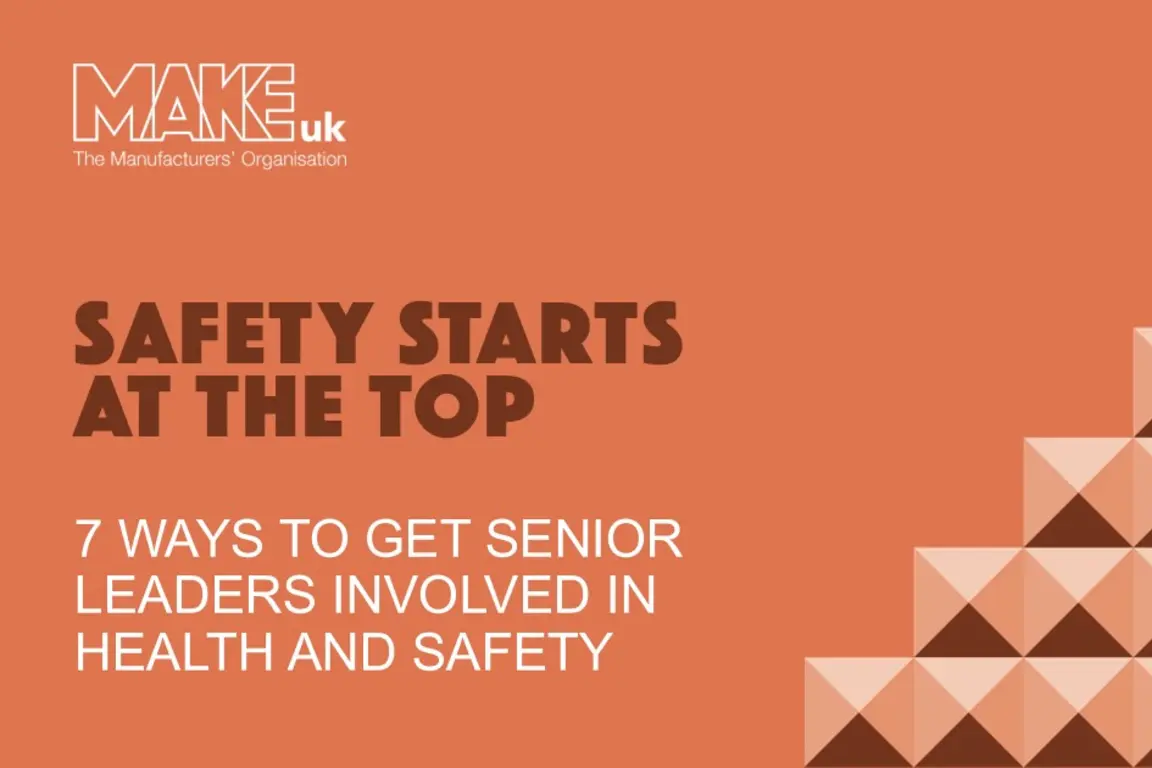07.07.2025
In a recent Make UK poll over 50% of respondents told us that senior leadership involvement is the area most in need of improvement in relation to workplace safety.
Senior leadership involvement isn’t a bonus – it’s a foundation. It protects people, strengthens compliance, and builds better businesses. Their actions shape culture, drive compliance, and, most importantly influence behaviours. We’ve seen firsthand how visible, engaged leadership creates safer, more resilient, more productive organisations.
This isn’t just good practice, it’s a legal obligation. The Health and Safety at Work Act 1974 makes senior figures personally accountable for safety failings. And, standards like ISO 45001 require leadership to be active participants in promoting safety culture and open communication.
It’s a clear message: safety starts at the top.
You’re not alone
Yet, figures from the Make UK poll and results from a recent IOSH survey, which found only 38% of health and safety professionals said their senior leaders are actively involved in safety initiatives, shows there’s a gap between what should happen and what’s actually going on.
Why the gap? Common barriers include competing priorities, cultural habits, and lack of experience or confidence discussing health and safety.
The good news? Once senior leaders do get involved — even in small, but visible ways — the impact is significant. It improves trust, drives cultural change, and measurably improves business outcomes.
Why this matters now
In a time when organisations are under pressure to improve productivity, reduce costs, and attract talent, health and safety can be a powerful enabler. A strong safety culture improves employee wellbeing, reduces downtime, and builds a reputation that helps attract and retain skilled staff. Getting leadership actively involved helps unlock all these benefits.
So, how can you actually get senior leadership involved in a meaningful way?
Here are some practical ideas that go beyond box-ticking and help embed safety into the leadership culture.
Put health and safety on the board agenda
Start by ensuring health and safety has a regular slot in senior leadership meetings. This shouldn’t just be a quick stats update - use the time to discuss trends, incidents, near misses, and improvements. Share short case studies of recent events, near misses and examples of best practice, linking them to business risks or reputation. This helps make the discussion relevant and tangible.
Top tip - Inviting senior figures to be involved at the planning stage of a project, ensures that they are aware of any health and safety implications from the start.
Invite leaders to the shop floor
Nothing changes perception like seeing reality. Arrange regular "walkabouts" where executives visit different parts of the operation to speak with teams about safety. These don’t have to be audits, they should be opportunities to listen, learn, and show support.
Top tip – It’s important to help senior leaders understand the influence they have within the organisation and in some cases upskill them in how to positively impact health and safety related behaviours.
Set safety KPIs for leadership
If safety performance is only measured at the operational level, it can feel like someone else’s responsibility. Consider adding health and safety indicators to leadership scorecards - not just injury rates, but proactive measures like safety conversations, near miss reporting, or completion of training. Make sure key performance indicators (KPIs) are realistic, relevant, and connected to behaviours, not just outcomes.
Top tip – Ask yourself how many KPIs you have that focus on health, safety and wellbeing and compare that to the number of KPIs you have that measure commercial success.
Make safety personal
Help leaders connect safety to their personal values. Whether it's about protecting people, building trust, or sustaining long-term performance, there’s usually a personal motivation to tap in to. Use storytelling, past experiences or industry examples to spark that connection.
Top tip – Understand the values and motivations of your senior team and arm them with personal health and safety messages that are linked to them. The senior team need to emotionally connect with the message they’re delivering.
Include leadership in incident reviews
Involve senior leaders in reviewing serious incidents or high-potential near misses. Not to assign blame, but to model curiosity and ownership. Their involvement shows that safety is a priority and encourages a learning culture.
Top tip – Ensure that your organisation is a “learning” organisation rather than a “blame and punish” one. It’s almost impossible to properly manage health and safety in the latter.
Celebrate safety wins - publicly
Recognition shouldn’t stop at the factory floor. When teams or individuals make proactive safety improvements, make sure senior leaders are part of the recognition process. Whether it’s an email, a shout-out at a meeting, or a personal thank you, it reinforces positive behaviours. Make it timely and specific - the more visible and genuine the praise, the greater its impact.
Top tip – In terms of cultural change, senior level recognition is far more powerful and longer-lasting than a financial token that is soon forgotten.
Invest time in leadership training
Many senior leaders haven’t had formal training in safety leadership. Providing short, targeted development sessions - focused on their role in shaping culture, asking the right questions, and leading by example - can be a game changer. Explore leadership training with Make UK - Leadership - Health and Safety Courses.
Top tip – The most expensive part of any training programme is the time that your staff give up to attend, therefore it’s critical to ensure that the training intervention is of the right quality and tailored as much as possible to your organisation.
Involving senior leadership in health and safety isn’t about turning them into safety experts - it’s about making safety a visible, lived value in the organisation.
Start small, be consistent, and keep the message clear: safety is a leadership issue – and a business opportunity.
For more information and support, please contact us – email [email protected] or call 0808 168 5874.
